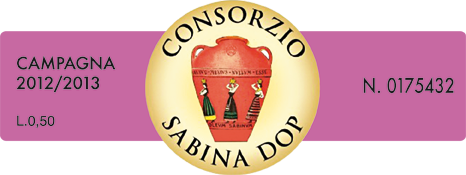
"Sabina DOP" official seal. Each bottle of Sabina DOP-certified oil is given a unique number to trace it back to the producer.
The “Sabina DOP Extra Virgin Olive Oil” seal is given by the Rome Chamber of Commerce, a public authority, to those oils that are produced according to the Sabina DOP Production Guidelines, which closely regulate every single step of the production, including:
Territory of Sabina.
The entire production process, from the planting of the trees to the bottling of the oil, must take place within the Sabina region.
Variety of the olive trees.
Typically, Sabina olives must come from the following varieties of olive trees: Carboncella, Leccino, Raia, Pendolino, Frantoio, Moraiolo, Olivastrone, Salviana, Olivago, Rosciola.
Yield of olives per hectare of land.
No more than about 6 tons of olives can be produced per each hectare (2.47 acres), which prevents overproduction and exploitation of the soil.
Harvest time.
Typically October-November.
Pressing.
The olives must be pressed within 48 hours from picking. Before being pressed, the olives must be washed with water. No other treatment is allowed.
Extraction.
The extraction of the oil from the olives takes place only through a mechanical process. No chemical process of any sort is permitted.
Yield of oil per olive.
The yield in oil cannot exceed 25% of the olives' weight.
Storing.
Olive oil must be carefully stored in stainless steel containers equipped with nitrogen-based system to prevent oxygen from coming in contact with the oil. The oil must be kept at a constant temperature between 12 and 16 Celsius degrees (53.6-60.8 Fahrenheit degrees).
Bottling.
Bottling must take place in one of the 15 Sabina DOP-certified bottling facilities. The olive oil must be bottled in glass, aluminum or ceramic containers no bigger than 5 liters.
Labelling.
There are strict guidelines on how a Sabina DOP olive oil can and must be labelled. Among other things, the words "Sabina DOP" must appear prominently on the label.
Chemical composition and sensory quality of the oil.
At the time it is put on the market, Sabina DOP must have the following features:
- Appearance: yellow/green with shades of gold.
- Aroma: fruity.
- Taste: one or more of the following: fruity, velvety, smooth, aromatic, sweet, bitter & spicy when freshly pressed.
- Acidity: no more than 0.6%.
Acidity is one of the most important and easily understandable parameters for quality. According to the International Olive Oil Council, the most important international organization to set olive oil standards, an extra virgin olive oil must not have more than 0.8% acidity. The maximum level allowed for Sabina DOP is 0.6%. Osco Sabina DOP has an average of 0.1-0.3%. - Peroxides: ≤14 (mEq O2 / kg).
The level of peroxides is a very important parameter for quality. Peroxides are the primary products of oxidation of olive oil. The higher the peroxides, the lower the quality. According to the International Guidelines, to be considered “extra virgin”, an olive oil must not have more than 20 mEq O2/kg. According to the Sabina DOP’s guidelines, it must not have more than 14 mEq O2/kg. Osco Sabina DOP has an average of 6-8 mEq O2/kg. - Panel Test: median of the defects = 0. Median of fruitiness: > 0.
To be certified as “Sabina DOP” an olive oil must be tested by a test panel formed by six professional olive oil tasters. To pass the test, the olive oil must be found to have no defects and to have at least one positive “taste” attribute. The International Guidelines require no defects, but do not require any positive attribute.
